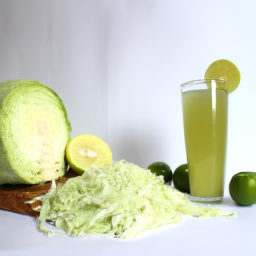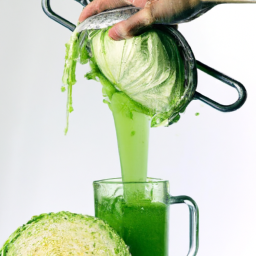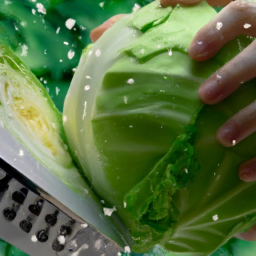Juice Tips and Tricks
How To Make Cabbage Juice
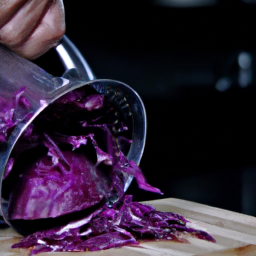
I have always been fascinated by the power of natural remedies to heal our bodies. Lately, I have become intrigued by cabbage juice. This humble vegetable, often overlooked in the produce aisle, is packed with essential vitamins and minerals that can greatly enhance our overall health in numerous ways.
In this article, I will guide you through the process of making cabbage juice, from choosing the right cabbage to storing and serving your finished product.
Before we dive into the nitty-gritty of cabbage juice, let’s talk about why it’s worth incorporating this drink into your daily routine. Cabbage is a cruciferous vegetable, which means it belongs to the same family as broccoli, cauliflower, and Brussels sprouts. These vegetables are known for their high levels of antioxidants and anti-inflammatory compounds, which can help protect against chronic diseases like cancer and heart disease.
Cabbage is also rich in vitamin C, vitamin K, and fiber, which support a healthy immune system and digestion. By drinking cabbage juice regularly, you can reap these benefits in a concentrated form that is easily absorbed by your body.
Key Takeaways
- Cabbage juice is a natural remedy with numerous health benefits, including boosting the immune system and improving digestion.
- Consuming too much cabbage juice can cause bloating, gas, and diarrhea, and may interfere with thyroid function in people with thyroid disorders.
- Choosing the right cabbage for juicing is important, with green cabbage being the most common and red cabbage containing more antioxidants and vitamin C.
- There are two main types of juicers: centrifugal and masticating, with masticating juicers producing higher quality juice. Adding lemon or ginger can boost nutritional value and flavor, and cabbage juice can be stored in an airtight container in the fridge for 3-4 days.
Health Benefits of Cabbage Juice
You’re gonna love how cabbage juice can boost your immune system and improve digestion! Cabbage is a nutrient-dense vegetable that contains a rich array of vitamins and minerals, including vitamins C and K, folate, and potassium. Drinking cabbage juice can help to promote healthy digestion by containing enzymes that break down food and promote healthy bowel movements.
It also contains sulforaphane, a compound that has been shown to have anti-inflammatory properties. However, it’s important to note that consuming too much cabbage juice can have potential side effects, such as bloating, gas, and diarrhea. Additionally, cabbage contains goitrogens, which can interfere with thyroid function in people with thyroid disorders.
Therefore, it’s important to talk to your healthcare provider before consuming large amounts of cabbage juice. When choosing the right cabbage for juicing, look for fresh, firm heads of cabbage with crisp, green leaves. Avoid cabbages with wilted, discolored, or damaged leaves, as these may indicate decay or disease.
Choosing the Right Cabbage
When choosing cabbage, I always consider two important factors: color and farming practices.
Green cabbage is the most common variety and has a milder taste than red cabbage. However, red cabbage contains more antioxidants and is a great source of vitamin C.
When it comes to farming practices, I prefer to buy organic cabbage to avoid exposure to harmful pesticides and chemicals.
Green vs. Red Cabbage
Although both green and red cabbage can be used to make cabbage juice, the latter tends to have a more vibrant color and slightly sweeter taste due to its higher levels of anthocyanins. Anthocyanins are a type of antioxidant that gives red cabbage its signature hue and are also believed to have anti-inflammatory properties.
In terms of nutritional differences, red cabbage contains more vitamin C, vitamin K, and folate than green cabbage, making it a great addition to any diet. When it comes to red cabbage recipes, the possibilities are endless. From slaws to salads to stir-fries, this versatile vegetable can add both flavor and nutrition to any dish. Plus, the deep red hue can make for a visually stunning presentation.
Moving on to the next section about organic vs. conventional, it’s important to note that the nutritional content of both green and red cabbage can vary depending on how they’re grown and harvested.
Organic vs. Conventional
If you’re looking to maximize the nutritional benefits of your cabbage, organic is the way to go – it’s like a vitamin explosion in your mouth! Organic farming practices prohibit the use of synthetic pesticides, which can linger on conventionally grown produce and potentially harm human health. In fact, studies have shown that organic produce has higher levels of beneficial nutrients, such as vitamin C and antioxidants, compared to conventionally grown produce.
To further illustrate the differences between organic and conventional farming, consider the following table:
| Organic farming | Conventional farming | |
|---|---|---|
| Pesticide use | Prohibited | Allowed |
| Fertilizer use | Limited to natural sources | Synthetic fertilizers used |
| Soil health | Prioritized through crop rotation and natural fertilizers | Not prioritized, leading to soil degradation |
As you can see, organic farming practices prioritize both human and environmental health. By choosing organic cabbage, you’re not only supporting sustainable farming practices, but also getting more nutritional bang for your buck. Now, let’s move on to preparing your cabbage for juicing.
Preparing Your Cabbage
First, you’ll need to chop the cabbage into small pieces before placing it in a blender. Shredding techniques are also an option, but chopping the cabbage into small pieces will yield a finer juice. If you prefer a milder flavor, you can blanch the cabbage before blending it. To do this, simply boil the chopped cabbage in water for a few minutes, then quickly transfer it to an ice bath to stop the cooking process.
Here are four steps to prepare your cabbage for juicing:
-
Choose a fresh head of cabbage that’s firm and heavy for its size, with crisp leaves.
-
Remove any wilted or discolored outer leaves and rinse the cabbage under cold running water.
-
Cut the cabbage in half and remove the core.
-
Chop the cabbage into small pieces or use a shredding technique, and blanch it for a milder flavor.
After preparing your cabbage, you can move on to choosing your juicer.
Choosing Your Juicer
When choosing your juicer, you’ll want to consider the type of produce you’ll be juicing and the quality of juice you want to achieve. There are two main types of juicers: centrifugal and masticating. Centrifugal juicers are typically more budget friendly and work well for juicing hard fruits and vegetables, like apples and carrots. They work by using a high-speed spinning blade to extract the juice. However, they can produce heat and oxidation, which can lead to a lower quality and less nutritious juice.
On the other hand, masticating juicers are typically higher end and can produce a higher quality juice. They work by crushing and squeezing the produce, resulting in a slower and more thorough extraction process. This can lead to a higher yield of juice and a more nutritious final product. However, they can also be more expensive and take up more space in your kitchen. Consider your budget and juicing needs when deciding which type of juicer to invest in. Now that you have chosen your juicer, let’s move on to the basic cabbage juice recipe.
Basic Cabbage Juice Recipe
To create a refreshing and nutrient-packed drink, you’ll want to grab some fresh cabbage and follow these simple juicing techniques.
First, rinse the cabbage thoroughly under cold water and chop it into small pieces. Then, feed the cabbage through your juicer, making sure to push it down gently to extract as much juice as possible. Once all the cabbage has been juiced, you can strain the liquid to remove any excess pulp, depending on your texture preference. For those new to this process and curious about how to prepare cabbage juice, it’s essential to use fresh, organic cabbage for the best flavor and nutritional benefits. Finally, pour the juice into a glass and enjoy immediately or refrigerate for later use.
Cabbage is a great source of vitamins C and K, as well as fiber and antioxidants. Juicing cabbage allows you to consume these nutrients in a concentrated form, which can provide a variety of health benefits.
Adding a little lemon or ginger to your basic cabbage juice recipe can also help boost its nutritional value and add some extra flavor. In the next section, we’ll explore some tasty flavor variations to help you customize your cabbage juice to your taste preferences.
Flavor Variations
You’re in for a treat with the following flavor variations that will have your taste buds dancing with excitement.
Cabbage juice can be combined with other juices to create a unique flavor profile. One option is to mix it with apple juice to balance out the earthy taste of the cabbage. Another option is to add a kick of spice by mixing in ginger or turmeric juice. These spice combinations not only add flavor but also have health benefits such as reducing inflammation and aiding digestion.
If you want to experiment with your own flavor combinations, try adding a splash of lemon or lime juice for a citrusy twist or mixing in some carrot juice for a sweeter taste. The possibilities are endless when it comes to mixing cabbage juice with other juices, so feel free to get creative. Just remember to use fresh, high-quality ingredients for the best taste and nutritional benefits.
When it comes to storing and serving your juice, there are a few things to keep in mind.
Storing and Serving Your Juice
Get ready to enjoy your freshly made cabbage juice by properly storing and serving it for maximum freshness and flavor. Here are some tips for storing and serving your cabbage juice:
-
Store your cabbage juice in an airtight container in the refrigerator for up to 3-4 days. This will help to preserve its freshness and prevent it from spoiling.
-
Shake the container well before serving to ensure that the juice is mixed properly. Cabbage juice tends to settle over time, so it’s important to mix it up before serving.
-
Serve your cabbage juice cold or at room temperature. You can add ice cubes to make it more refreshing on a hot day.
-
If you find that your cabbage juice is too thick, you can dilute it with some water or add some other juice, such as apple or carrot juice, to make it more palatable.
-
For a more flavorful and nutritious juice, consider adding other ingredients such as ginger, lemon, or green apple. These ingredients will not only enhance the flavor of your cabbage juice but also provide additional health benefits.
Now that you know how to properly store and serve your cabbage juice, let’s move on to some tips and tricks for making it taste even better.
Tips and Tricks
Enhance the flavor of your freshly made cabbage juice by experimenting with various juicing techniques and ingredients. Adding a slice of zesty ginger or a squeeze of tangy lemon can add a burst of excitement to your taste buds. You can also try juicing other vegetables and fruits, such as carrots or apples, to create a unique flavor profile.
Remember to use fresh and high-quality ingredients to maximize the nutritional value of your juice. When juicing cabbage, it’s important to keep safety precautions in mind. Always wash your hands and produce thoroughly before juicing. Use a clean and sanitized juicer, and make sure to discard any spoiled or rotten produce.
By following these simple tips and tricks, you can make a delicious and nutritious cabbage juice that’s both flavorful and safe to consume.
Safety Precautions
Now that we’ve discussed some tips and tricks for making cabbage juice, it’s important to address safety precautions when handling raw cabbage. Proper equipment, such as a sharp knife and cutting board, are essential for minimizing the risk of injury.
When cutting cabbage, it’s important to use a stable surface and keep fingers away from the blade to avoid accidental cuts.
In addition to using proper equipment, it’s important to follow proper handling procedures to prevent the spread of harmful bacteria. Cabbage should be thoroughly washed before use to remove any dirt or debris that may be present.
It’s also important to use clean hands and utensils when handling cabbage to prevent contamination.
By following these safety precautions, we can ensure that our cabbage juice is not only delicious but also safe for consumption.
Frequently Asked Questions
Can cabbage juice be consumed by people with certain medical conditions, such as ulcers or thyroid problems?
As someone with medical conditions like ulcers or thyroid problems, I’ve researched the benefits and risks of drinking cabbage juice. It can aid digestion and boost immunity, but may interfere with thyroid medication. Variations like adding lemon or ginger can make it enjoyable in daily meals and snacks.
How long does it take to see health benefits from drinking cabbage juice regularly?
Based on scientific evidence, regular consumption of cabbage juice benefits overall health, including digestion and immune function. The best time to drink cabbage juice is on an empty stomach in the morning. Results may vary.
Can cabbage juice be used in cooking or baking recipes?
Using cabbage juice in savory dishes adds a unique flavor and nutritional boost. It can be incorporated into smoothies for a healthy drink option. However, it may not be suitable for baking due to its strong taste.
What is the recommended serving size for cabbage juice?
The recommended serving size for cabbage juice is 8-16 ounces per day. Cabbage juice alternatives include incorporating cabbage into smoothies or soups. Creative cabbage juice recipes include adding lemon or ginger for added flavor.
Are there any side effects or potential interactions with medications when consuming cabbage juice?
Before consuming cabbage juice, it’s important to note that it may interact with certain medications. Pregnant women should also consult their doctor before drinking it. Always consult a healthcare provider before adding a new food to your diet.
Conclusion
In conclusion, making cabbage juice is a simple and cost-effective way to add valuable nutrients to your diet. Just like a caterpillar transforms into a butterfly, the cabbage transforms into a powerful elixir once juiced.
By choosing the right cabbage, preparing it properly, and using the right juicer, you can unlock the numerous health benefits that cabbage juice provides. So, why not give it a try? Become the scientist in your own kitchen and experiment with different flavor variations to suit your taste buds.
With proper storage and serving techniques, you can enjoy the benefits of cabbage juice all week long. Remember to take safety precautions and seek medical advice before starting any new dietary regime. Cheers to your health and transformation!
Cindy thoroughly researches juicing trends, techniques, and recipes to provide readers with practical advice and inspiration. Her writing style is accessible, engaging, and designed to make complex concepts easy to understand. Cindy’s dedication to promoting the advantages of juicing shines through her work, empowering readers to make positive changes in their lives through the simple act of juicing.
Juice Tips and Tricks
How Does Aloe Vera Juice Taste

I recently began incorporating aloe vera juice into my daily regimen, and initially, I was a little reluctant. The idea of consuming a liquid derived from the same spiky plant that grows on my windowsill felt odd. However, after conducting some research, I learned that aloe vera juice offers a range of health benefits, including improving digestion and enhancing the immune system. Consequently, I made the choice to give it a chance.
Now, the question on everyone’s mind when it comes to aloe vera juice is, how does it taste? Well, let me tell you, it’s not your typical juice flavor. It has a unique taste that can be a bit difficult to describe. But don’t worry, I’m here to break it down for you.
In this article, we’ll explore the factors that affect the taste of aloe vera juice, common taste descriptions, and even some tips for improving the taste. So, let’s dive in and discover the taste of aloe vera juice together.
Key Takeaways
- Aloe vera juice can have a slightly bitter taste with a hint of sweetness, or it can be refreshing and slightly sweet, bitter and unpleasant, or mild and earthy, depending on the mixing preferences and ingredient combinations used.
- Some brands may use additives or preservatives that can alter the flavor of aloe vera juice.
- Aloe vera juice is rich in nutritional content, containing vitamins, minerals, and amino acids that provide numerous health benefits, such as aiding in digestion, boosting the immune system, and helping with skin health.
- Experimenting with different flavor combinations can help you enjoy the health benefits of aloe vera juice without sacrificing taste, and it can be consumed in other ways besides drinking it straight, making it a versatile addition to any beverage lineup.
Overview of Aloe Vera Juice
You’ll be pleasantly surprised by how refreshing aloe vera juice tastes. It has a subtle sweetness with a slightly tangy and refreshing aftertaste.
Aloe vera juice is made from the gel-like substance found inside the leaves of the aloe vera plant. The juice is packed with vitamins, minerals, and antioxidants that provide numerous health benefits, making it a popular health drink.
Aloe vera juice is easy to prepare, and it can be made at home by blending the gel with water. It’s essential to store the juice in the refrigerator to maintain its freshness and prevent spoilage.
Aloe vera juice has a mild taste that makes it easy to mix with other juices and smoothies. As we move on to the next section, we’ll explore the factors that can affect the taste of aloe vera juice.
Factors that Affect Taste
Savor the subtle sensations of sweet and sour, as the flavor of aloe vera juice is shaped by several factors. One of the biggest influences on taste is personal flavor preferences. Some people enjoy the slightly bitter taste of aloe vera juice, while others find it too overpowering.
Additionally, ingredient combinations can greatly affect the taste. For example, adding citrus or sweet fruits can help mask the bitterness and make the juice more palatable.
Another factor that contributes to the taste of aloe vera juice is the processing method used. Some brands may use additives or preservatives, which can alter the flavor. It’s important to read labels and choose a brand that uses natural ingredients and minimal processing.
Overall, the taste of aloe vera juice can be described as slightly bitter with a hint of sweetness. In the next section, we’ll explore common taste descriptions in more detail.
Common Taste Descriptions
When it comes to describing taste, I find that there are three common categories that most flavors fall into: refreshing and slightly sweet, bitter and unpleasant, and mild and earthy.
The first category can be found in drinks like lemonade or watermelon juice, where the sweetness isn’t overpowering but adds a pleasant note to the overall taste.
Bitter and unpleasant flavors are often found in strong coffee or certain types of vegetables, and can be an acquired taste for some.
Lastly, mild and earthy flavors can be found in foods like mushrooms or grains, and offer a subtle but satisfying taste.
Refreshing and Slightly Sweet
Feeling parched on a hot summer day? Take a sip of aloe vera juice and taste the refreshing, slightly sweet flavor that will quench your thirst. The taste is a perfect match for those who love refreshing drinks and natural sweeteners.
The refreshing nature of aloe vera juice comes from its cooling properties, which soothe the body and provide relief from the heat. Meanwhile, the natural sweetness of the juice comes from the natural sugars present in the plant. This combination creates a flavor that is light and subtle, making it a great option for those who are looking for a healthy and refreshing drink.
However, not all aloe vera juices are created equal, and some may have a bitter and unpleasant taste.
Bitter and Unpleasant
You may find that some aloe vera juices leave a bitter taste in your mouth, like a mouthful of unripe grapefruit. This is because the inner gel of the aloe plant contains aloin, a yellow-colored compound that can be quite bitter when ingested.
Taste preference plays a significant role here, as some people may enjoy the bitterness, while others may find it unpleasant. However, it’s worth noting that not all aloe vera juices taste like this, as some brands add flavor additives to mask the bitterness and enhance the overall taste.
If you have a specific preference for a certain flavor, you may want to check the ingredients of the aloe vera juice before purchasing it. Some brands may use natural flavorings like honey or lemon to provide a sweet taste, while others may use artificial sweeteners or preservatives that can affect the overall flavor. Alternatively, you can opt for a pure aloe vera juice that doesn’t contain any additional flavor additives, but be prepared for a slightly bitter taste.
Moving on to the next section, some aloe vera juices have a mild and earthy taste that is quite different from the bitter one we just discussed.
Mild and Earthy
Imagine taking a sip of aloe vera juice and being transported to a serene forest. The mild and earthy taste reminds you of the freshness of nature. The flavor profile of aloe vera juice is subtle, with a slightly sweet and herbaceous taste. Unlike other bitter and unpleasant health drinks, aloe vera juice is refreshing and easy to drink.
As for pairing suggestions, aloe vera juice goes well with citrus fruits like lemon and lime, as well as other juices such as pineapple and apple. It can also be mixed with herbal teas or added to smoothies for an extra boost of nutrients. With its mild and earthy taste, aloe vera juice is a versatile addition to any beverage lineup.
Drinking aloe vera juice not only tastes good, but it also provides numerous health benefits.
Health Benefits
Experiencing the health benefits of aloe vera juice is worth it, as it can aid in digestion, boost your immune system, and even help with skin health. Aloe vera juice is rich in nutritional content, containing vitamins like C, E, and B12, minerals like calcium and magnesium, and amino acids. Scientific research suggests that aloe vera juice can also help reduce inflammation and regulate blood sugar levels.
It’s important to follow dosage recommendations when consuming aloe vera juice, as it can have potential interactions with certain medications. It’s best to start with a small amount and gradually increase the dosage, monitoring how your body reacts. If you experience any adverse effects, stop consuming the juice and consult with your healthcare provider.
Incorporating aloe vera juice into your daily routine can have numerous health benefits, but it’s important to do it safely and responsibly. When looking to improve the taste of aloe vera juice, there are a few tips that can help. Mixing it with other juices, like orange or pineapple, can help balance out the earthy taste. Adding a small amount of honey or agave syrup can also sweeten the juice without adding too much sugar. Experimenting with different flavor combinations can help you find a way to enjoy the health benefits of aloe vera juice without sacrificing taste.
Tips for Improving Taste
Sprucing up the flavor of aloe vera juice can be tough, but with a little creativity and outside-the-box thinking, you can turn it into a delicious and refreshing beverage that hits the spot. Here are some tips for improving the taste of aloe vera juice:
-
Flavor balancing: Aloe vera juice has a strong, bitter taste that can be overwhelming. To balance out the flavor, try adding a splash of citrus juice, such as lemon or lime. This will help tone down the bitterness and add a tangy, refreshing taste.
-
Natural sweeteners: If you prefer a sweeter taste, try adding a natural sweetener such as honey or agave syrup. These sweeteners will add a touch of sweetness without overpowering the natural flavor of the aloe vera.
-
Mix with other juices: Mixing aloe vera juice with other fruit juices can help improve the taste and make it more palatable. Try mixing aloe vera juice with apple, pineapple, or mango juice for a delicious and refreshing beverage.
-
Chill before serving: Aloe vera juice tastes best when served cold. Chill the juice in the refrigerator before serving, or add ice cubes to the glass for a refreshing and cooling drink.
With these tips, you can make aloe vera juice taste great and enjoy the many health benefits it has to offer. Alternatively, there are other ways to consume aloe vera that don’t involve drinking it straight.
Alternative Ways to Consume Aloe Vera
One tasty way to reap the health benefits of aloe vera is by adding it to smoothies or other blended drinks. I love making a refreshing smoothie with aloe vera juice, spinach, pineapple, and avocado. The aloe vera adds a subtle sweetness and a refreshing taste that complements the other ingredients perfectly.
Another way to use aloe vera in skincare is by mixing it with other natural ingredients like honey, turmeric, or cucumber to make a soothing face mask. This can help to hydrate, soothe, and rejuvenate the skin, leaving it looking and feeling healthy and radiant.
In addition to these delicious and nourishing ways to use aloe vera, there are also a variety of supplements available that can help promote overall health. Aloe vera supplements are available in many forms, including capsules, gummies, and powders. These supplements can help support digestion, boost the immune system, and improve skin health. However, it’s important to be aware of any potential risks and side effects associated with aloe vera supplements, which we will explore in the next section.
Risks and Side Effects
Be aware of the potential risks and side effects associated with taking aloe vera supplements, as they can affect your digestion, skin health, and immune system. Here are some potential discussion ideas for risks and side effects:
-
Allergic reactions: Some people may be allergic to aloe vera and experience symptoms such as hives, itching, and swelling. It’s important to perform a patch test before consuming aloe vera supplements or applying aloe vera topically.
-
Interactions with medication: Aloe vera may interact with certain medications, including diabetes medications, diuretics, and heart medications. It’s important to talk to your healthcare provider before taking aloe vera supplements if you’re on any medication.
-
Diarrhea: Aloe vera supplements may cause diarrhea in some people, especially if taken in large amounts. It’s important to follow the recommended dosage on the label and start with a small amount to see how your body reacts.
-
Skin irritation: Applying aloe vera topically may cause skin irritation in some people, especially those with sensitive skin. It’s important to perform a patch test before using aloe vera topically and diluting it with water or a carrier oil if needed.
When it comes to choosing the right aloe vera juice, it’s important to consider the quality and purity of the product.
How to Choose the Right Aloe Vera Juice
After discussing the potential risks and side effects of consuming aloe vera juice, let’s move on to the next important aspect of choosing the right aloe vera juice – taste preference. As someone who’s tried various brands of aloe vera juice, I can attest that the taste can vary greatly.
Some brands have a bitter taste, while others have a milder, sweeter taste. It’s important to choose a brand that aligns with your personal taste preferences to make the experience more enjoyable.
When choosing brands, it’s important to read the labels and ensure that the aloe vera juice is made from pure, organic aloe vera gel. Some brands may contain added sugars or artificial flavors which can affect the taste and overall health benefits of the juice.
Additionally, it’s important to consider the processing method of the aloe vera juice. Cold-pressed juices are gentler on the plant’s nutrients and may have a more potent taste, while heat-processed juices may have a milder taste but may not retain as many nutrients.
Now that we’ve covered how to choose the right aloe vera juice, let’s explore where to buy it.
Where to Buy Aloe Vera Juice
I love a good aloe vera juice, and finding the right place to buy it is important to me. Personally, I prefer shopping at health food stores because they generally have a wider selection of brands and products.
However, if I can’t find what I’m looking for there, I also like to check out online retailers and specialty shops that specialize in natural and organic products.
Health Food Stores
You’ll find a variety of aloe vera juice options at health food stores, each with its own unique taste and potential health benefits. I personally love going to my local health food store to browse their selection of aloe vera juice. It’s always exciting to try out new brands and flavors, and I find that health food stores often carry some of the more unique and niche options.
One of the benefits of buying aloe vera juice at a health food store is that you can typically find high-quality, organic options. However, some of these options may come with a higher price tag. Popular brands that I’ve seen at health food stores include Lily of the Desert, ALO, and Fruit of the Earth. While aloe vera juice can have a slightly bitter taste, some brands add sweeteners or other flavors to make it more palatable. Overall, I highly recommend checking out your local health food store for a wide selection of aloe vera juice options.
Moving on to the next section about online retailers, you can also find a great selection of aloe vera juice options online.
Online Retailers
Shopping online for aloe vera juice is like opening a treasure chest of healthy possibilities, with a plethora of brands and flavors to explore. Here are some reasons why I love browsing through online retailers for my aloe vera juice needs:
-
Customer Reviews: Online retailers have a section for customer reviews that I find very helpful in making my purchase decisions. I can read what others have to say about a specific brand or flavor and get a better idea of what to expect.
-
Shipping Policies: Most online retailers offer free shipping or have a minimum order requirement to qualify for free shipping. This is a great way to save money and stock up on my favorite aloe vera juice without leaving the comfort of my home.
-
Variety of Brands: Online retailers carry a wide range of brands, from well-known ones to more niche options. This allows me to try new brands and flavors that I may not be able to find in my local health food store.
-
Convenience: Shopping online for aloe vera juice is convenient and saves me time. I can easily compare prices, read reviews, and make my purchase without leaving my home.
-
Discounts and Deals: Online retailers often have special promotions, discounts, and deals that I can take advantage of. This helps me save money and try new products without breaking the bank.
As much as I enjoy browsing through online retailers, I also love visiting specialty shops for my aloe vera juice needs.
Specialty Shops
Walking into a specialty shop for aloe vera juice is like stepping into a world of organic, natural goodness. The ambiance is calming, and the smell of fresh aloe vera leaves fills the air.
The walls are lined with bottles of aloe vera juice, each with their unique blends and specialty flavors. As I look around the shop, I notice the various juices with flavors like pineapple, mango, and strawberry. The colors of the juices are inviting and look refreshing.
I’m intrigued by the unique blends that the shop offers, like aloe vera mixed with ginger and honey. I try a sample of the ginger-honey blend, and it’s surprisingly refreshing. The taste is sweet with a hint of spice, and the aloe vera isn’t overpowering.
Specialty shops offer a wider variety of aloe vera juice flavors, making the experience more enjoyable.
Frequently Asked Questions
Can aloe vera juice be used topically on the skin?
Using aloe vera juice topically on the skin can have numerous benefits. It’s known for its ability to soothe and hydrate the skin, reduce inflammation, and even help with acne. I highly recommend incorporating it into your skincare routine.
What is the recommended daily dosage of aloe vera juice?
I recommend consuming 2-4 ounces of aloe vera juice daily, but be cautious as it may cause diarrhea or stomach discomfort. While it’s a natural remedy, it’s still important to consult with a healthcare professional before use.
Is aloe vera juice safe for pregnant women to consume?
As a pregnant woman, I researched the benefits and risks of consuming aloe vera juice. It may cause uterine contractions and diarrhea, and there is limited research on its safety. Consult with a healthcare provider before consuming.
Can aloe vera juice be mixed with other drinks or ingredients?
Mixing options for aloe vera juice are endless. Personally, I prefer to mix it with citrus fruits for a tangy kick. Depending on taste preferences, it can also be blended with honey, ginger, or even coconut water.
How long does a bottle of aloe vera juice typically last once opened?
Once opened, a bottle of aloe vera juice typically lasts for about a week in the refrigerator. It’s important to store it properly by keeping it tightly sealed and away from direct sunlight. Check the expiration date before consuming. Similarly, it’s crucial to be mindful of how long celery juice lasts after opening. Generally, celery juice should be consumed within 2 to 3 days if refrigerated to maintain its freshness and nutritional benefits. Always ensure both aloe vera and celery juice are stored in airtight containers to avoid spoilage.
Conclusion
Well, there you have it folks – the taste of aloe vera juice can be quite polarizing. But with its numerous health benefits, it’s definitely worth a shot.
For me, the taste is reminiscent of a slightly bitter cucumber with a hint of sweetness. It’s not the most delicious drink out there, but it’s definitely tolerable.
If you’re having trouble with the taste, try mixing it with other flavors like citrus or honey to make it more enjoyable. Alternatively, you can try consuming it in a different form like a capsule or gel.
But remember, always choose a high-quality aloe vera juice to ensure that you’re getting all the benefits and none of the risks. So go ahead, give it a try and see how your taste buds react. Who knows, you might just discover your new favorite health drink!
Cindy thoroughly researches juicing trends, techniques, and recipes to provide readers with practical advice and inspiration. Her writing style is accessible, engaging, and designed to make complex concepts easy to understand. Cindy’s dedication to promoting the advantages of juicing shines through her work, empowering readers to make positive changes in their lives through the simple act of juicing.
Juice Tips and Tricks
How Does Lemon Juice Cook Shrimp
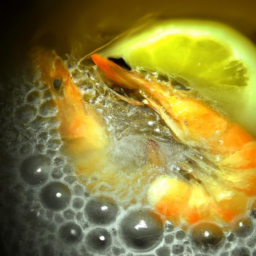
As an experienced chef, I have tried out different methods for cooking shrimp. One particular technique that has caught my interest is using lemon juice to marinate the shrimp.
At first, it may seem counterintuitive to use an acidic ingredient to cook seafood, but the process, known as cooking by acid, is a common cooking method that is used in many cuisines around the world. Cooking by acid is a process where the acid in a marinade or sauce breaks down the proteins in the food, resulting in a tender and flavorful dish.
When it comes to shrimp, lemon juice is a popular ingredient in marinades, dressings, and sauces. But can it actually cook the shrimp? In this article, I will explore the science behind this cooking method, the steps to preparing and marinating shrimp with lemon juice, and alternative cooking methods to consider.
Key Takeaways
- Lemon juice is a popular ingredient in marinades, dressings, and sauces for shrimp, and can be used to cook shrimp through a process called cooking by acid.
- Cooking with acid is a healthier option as it does not require added fats or oils, and lemon juice is less harsh than other acids, such as vinegar or lime juice, which can overpower the delicate flavor of the shrimp.
- Marinating the shrimp in lemon juice for 10-15 minutes before cooking can help to infuse the flavor into the shrimp and ensure that it is evenly coated, and adding herbs and spices can help to add depth and complexity to the dish.
- Fresh lemon juice is important to use as bottled juice can contain preservatives that can affect the taste and texture of the shrimp, and cooking with acid is a low-calorie cooking method that does not require added fats or oils.
What is Cooking by Acid?
So, how exactly does lemon juice work its magic in cooking shrimp? Well, it all comes down to a process called cooking by acid. This method, often referred to as “ceviche-style,” relies on the citric acid in the lemon juice to break down the proteins in the shrimp, effectively “cooking” it without heat. Similar to **how shrimp cooks in lime juice**, the acid causes the flesh to become firm and opaque, transforming the texture and flavor. This chemical reaction is what gives ceviche and other acid-cured seafood dishes their distinctive taste and appearance.
Acidic cooking benefits seafood and meat by tenderizing and breaking down proteins, making them easier to digest and chew. It also imparts a tangy, citrusy flavor that complements the natural sweetness of shrimp.
While lemon juice is the most commonly used acid for cooking seafood, other acids such as lime juice, vinegar, and wine can also be used. Each acid has its own unique flavor profile and can enhance the taste of certain dishes.
However, it’s important to use the right amount of acid to avoid overcooking or overpowering the dish. With the right balance, cooking by acid can transform a simple shrimp dish into a flavorful and tender meal. And that’s exactly what lemon juice does for shrimp!
Lemon Juice and Shrimp
I’ve always loved the tangy taste of shrimp cooked in lemon juice. But did you know that lemon juice is actually the ideal acid for cooking shrimp? Its high acidity helps to tenderize the shrimp and infuse it with flavor.
When choosing the right type of lemon juice, it’s important to look for one that is fresh and free of any additives or preservatives.
Why Lemon Juice is the Ideal Acid for Cooking Shrimp
Lemon juice is the most popular acid used for cooking shrimp, with over 80% of recipes calling for it. There are several advantages of using lemon juice over other acids when cooking shrimp. Firstly, lemon juice is less harsh than other acids, such as vinegar or lime juice, which can overpower the delicate flavor of the shrimp.
Secondly, lemon juice contains natural sugars that complement the sweetness of the shrimp, creating a perfect balance of flavors. Finally, lemon juice has a low pH level, which helps to denature the protein in the shrimp, resulting in a firmer and more tender texture.
To enhance the flavor of lemon juice cooked shrimp, there are a few tips to keep in mind. Firstly, it’s important to use fresh lemon juice, as bottled juice can contain preservatives that can affect the taste and texture of the shrimp. Secondly, adding herbs and spices, such as garlic, parsley, and red pepper flakes, can help to add depth and complexity to the dish. Finally, marinating the shrimp in lemon juice for 10-15 minutes before cooking can help to infuse the flavor into the shrimp and ensure that it is evenly coated.
When choosing the right type of lemon juice for cooking shrimp, it’s important to consider the acidity level and whether it’s sweet or sour. The next section will explore the different types of lemon juice and how to choose the best one for cooking shrimp.
How to Choose the Right Type of Lemon Juice
When selecting the ideal type of citrus for cooking shrimp, it’s essential to consider the acidity and sweetness of the lemon juice to achieve the perfect balance of flavors.
Some cooks prefer bottled lemon juice for its convenience and consistency, while others opt for fresh lemon juice for its bright, zesty flavor. When using bottled lemon juice, be sure to check the label for any added sugars or preservatives that may affect the taste of the dish.
Another factor to consider when choosing lemon juice is whether to use organic or conventional. Organic lemons are grown without the use of pesticides or synthetic fertilizers, making them a healthier and more environmentally friendly option. However, they may be more expensive and harder to find than conventional lemons.
Ultimately, the choice between bottled or fresh, and organic or conventional lemon juice, depends on personal preference and availability. With the right type of lemon juice, you can elevate the flavor of your shrimp dish to new heights.
Now that you’ve chosen the perfect lemon juice for your shrimp, it’s time to prepare the shrimp for cooking.
Preparing the Shrimp
Before we dive into cooking our shrimp, it’s important to properly prepare them. As someone who loves seafood, I’ve learned a few tips for choosing the best quality shrimp and how to clean and devein them.
First, always look for shrimp that have a firm texture and a slightly sweet smell.
Secondly, to clean and devein the shrimp, start by removing the head and shell. Then, make a shallow cut down the back to expose the vein and remove it with a knife or toothpick.
How to Clean and Devein Your Shrimp
First things first, you’ll want to grab your shrimp and give them a good rinse under cold water. This ensures that any dirt or debris is removed from the surface of the shrimp.
Next, it’s time to properly clean and devein your shrimp. To do this, use a sharp knife to cut along the back of the shrimp and remove the digestive tract. It’s important to remove this because it can give the shrimp a gritty texture and a bitter taste.
Proper cleaning is just the first step in preparing your shrimp for cooking. You’ll also want to season them properly to enhance their natural flavors. A simple mixture of lemon juice, garlic, and olive oil can do wonders for shrimp.
When cooking, the optimal time and temperature for perfect shrimp is about 2-3 minutes on each side over medium-high heat. With these techniques, your shrimp will be ready to cook in no time.
Now, let’s move on to tips for choosing the best quality shrimp.
Tips for Choosing the Best Quality Shrimp
Now that we know how to clean and devein our shrimp, we can move on to choosing the best quality shrimp for our recipe. It’s important to choose sustainable options to protect our oceans and avoid contributing to overfishing. But with so many options available, how do we know which ones to choose?
One way to ensure you’re getting high quality shrimp is to look for certain labels and certifications. For example, the Aquaculture Stewardship Council (ASC) and the Marine Stewardship Council (MSC) both certify sustainable seafood, including shrimp. Additionally, look for shrimp that have been caught or farmed in the USA, where regulations and monitoring are stricter compared to some other countries. It’s also important to avoid common shrimp scams, such as mislabeled shrimp or shrimp that has been treated with chemicals to enhance its color or size. By being a conscious consumer and choosing wisely, we can enjoy delicious shrimp while also protecting our environment.
Now that we’ve chosen the best quality shrimp for our recipe, it’s time to marinate them in lemon juice.
Marinating the Shrimp
To really infuse the shrimp with flavor, you’ll want to let them marinate in the lemon juice for at least 30 minutes. Marinating benefits the shrimp by tenderizing the meat and enhancing the flavor. The acidity levels in the lemon juice break down the protein in the shrimp, making it more tender and easier to cook.
Here are some tips to keep in mind when marinating shrimp:
- Use fresh lemon juice for the best flavor and results.
- Mix in some herbs and spices to add more depth to the marinade.
- Don’t marinate shrimp for too long as the acid can start to ‘cook’ the shrimp and make it tough.
- Make sure the shrimp is fully coated in the marinade to ensure even flavor distribution.
- Cover the marinating shrimp and store it in the refrigerator to prevent bacteria growth.
Once the shrimp has marinated, it’s time to cook it using the lemon juice. The acid in the lemon juice will continue to tenderize the shrimp as it cooks, making it juicy and flavorful.
Using Lemon Juice to Cook Shrimp
Using the tangy power of fresh lemon, you can transform a batch of shrimp into a flavor explosion that will transport you to the beaches of the Mediterranean – imagine the burst of sunshine on your tongue as you take that first bite.
One of the main benefits of using lemon juice to cook shrimp is that it helps to tenderize the meat, resulting in a more succulent and juicy texture. The acidity in the lemon juice also helps to neutralize the fishy smell and taste that shrimp can sometimes have, making it a more palatable seafood option.
Moreover, the use of lemon juice in cooking shrimp allows for a range of flavor variations, depending on the additional ingredients used. For example, adding garlic, herbs, and olive oil to the lemon juice can create a zesty and herbaceous flavor profile, while adding chili flakes and honey can create a sweet and spicy kick. The possibilities for experimentation are endless, making it a versatile ingredient in any seafood lover’s kitchen.
With the shrimp cooked to perfection, we can now move on to serving it in a variety of delicious and creative ways.
Serving Cooked Shrimp
You’ve got yourself a batch of succulent shrimp, cooked to perfection with the help of a tangy ingredient, and now it’s time to explore the endless possibilities of serving them up in delicious and creative ways. One way to do this is through creative plating. Presentation is key, so consider using colorful plates and garnishes like fresh herbs, chopped nuts, or sliced citrus fruits. For a more elegant touch, arrange the cooked shrimp on skewers and serve with a dipping sauce.
Pairing options are also important to consider when serving cooked shrimp. For a light and refreshing meal, serve the shrimp with a side salad or roasted vegetables. If you’re in the mood for something heartier, pair the shrimp with pasta or rice dishes. For a more adventurous meal, try serving the shrimp with exotic fruits like mango or pineapple. The possibilities are endless, so don’t be afraid to get creative!
As we’ve explored how to serve cooked shrimp, it’s important to note that lemon juice is not the only way to cook shrimp. Alternative cooking methods such as grilling, baking, or sautéing can also produce delicious results. Let’s take a look at some of these methods and how they can bring out different flavors in our favorite seafood.
Alternative Cooking Methods
As a chef, I always adhere to traditional cooking methods when preparing my dishes. However, sometimes it’s fun to experiment with other ingredients and acids to create new and unique flavors.
When using alternative cooking methods, it’s important to keep in mind the science behind the ingredients and their reactions to heat and other elements.
When to Use Traditional Cooking Methods
If you’re hesitant about using modern cooking techniques, such as sous vide or pressure cooking, you might want to consider the benefits of sticking to traditional methods for certain dishes.
When it comes to searing a steak or roasting a chicken, traditional methods can result in a better flavor and texture. This is because these techniques rely on high heat and direct contact with the food, which helps to create a crispy exterior and seal in the juices.
In addition to flavor and texture, traditional cooking methods also offer the benefit of being time-tested and reliable. While modern techniques may promise faster cooking times or more precise temperatures, they can also come with a learning curve and the potential for unexpected results. Traditional methods, on the other hand, have been used for generations and are often more forgiving when it comes to variations in ingredients or equipment.
So, when it comes to certain dishes, it may be worth sticking to the tried and true methods. Now, let’s explore how experimenting with other acids and ingredients can enhance your cooking even further.
Experimenting with Other Acids and Ingredients
To elevate your cooking, it’s worth exploring the use of different acids and ingredients that can add depth and complexity to your dishes. Experimenting with different acids, such as lime juice, vinegar, or even wine, can provide a new dimension of flavor to your shrimp dishes. When using acids, it’s important to remember that they can cook the shrimp, just like lemon juice does.
In addition to acids, exploring flavor combinations with ingredients such as garlic, ginger, and herbs can also enhance your shrimp dishes. For example, adding chopped garlic to your lemon juice marinade can provide a subtle yet delicious flavor boost. Experimenting with different ingredients and combinations can help you discover new and exciting ways to cook shrimp.
Now that you’ve experimented with acids and ingredients, it’s important to know how to store cooked shrimp to maintain their quality and freshness.
Storing Cooked Shrimp
Storing cooked shrimp properly will help maintain its freshness and flavor. After cooking, it is important to cool the shrimp quickly before storing them in the refrigerator. Leaving cooked shrimp at room temperature for too long can cause bacterial growth, which can lead to foodborne illness.
To store cooked shrimp, place them in an airtight container and store in the refrigerator for up to three days. If you need to store them for longer periods, freezing leftovers is the best option. To freeze cooked shrimp, place them in an airtight container or freezer bag and store in the freezer for up to three months. When reheating cooked shrimp, it is important to do so thoroughly, ensuring that the shrimp reaches an internal temperature of 165°F to prevent any possible bacterial growth.
Moving on to the subsequent section about the nutritional value of cooked shrimp, it is important to note that shrimp is a great source of protein and low in calories and fat.
Nutritional Value of Cooked Shrimp
As I delve deeper into the world of cooking shrimp, I’m increasingly drawn to the nutritional value of this delicious seafood.
In this subtopic, I’ll explore the health benefits of eating cooked shrimp. I’ll compare its nutritional value to other cooking methods. Additionally, I’ll summarize the cooking by acid technique and share some tips for mastering the art of cooking shrimp with lemon juice.
Health Benefits of Eating Cooked Shrimp
Eating cooked shrimp is like giving your body a boost of essential nutrients and vitamins, all while indulging in a deliciously savory and satisfying meal. Here are some of the health benefits of consuming cooked shrimp:
- Shrimp is a great source of protein, which is essential for building and repairing tissues in the body.
- Cooked shrimp contains high levels of omega-3 fatty acids, which are known to reduce inflammation and lower the risk of heart disease.
- Shrimp is low in calories and fat, making it a great option for those who’re watching their weight.
- The consumption of shrimp has been linked to improved brain function and a reduced risk of age-related cognitive decline.
- Cooked shrimp is a good source of vitamins and minerals, including vitamin B12, iron, and zinc.
As you can see, there are numerous benefits to incorporating cooked shrimp into your diet. In the next section, we’ll explore how the nutritional value of cooked shrimp compares to other cooking methods.
Nutritional Comparison to Other Cooking Methods
If you’re looking to maximize the nutritional value of your shrimp, you’ll be interested to know how different cooking methods stack up against each other. Comparing nutrient content, boiling and steaming are the best cooking methods to preserve the shrimp’s nutritional value.
Boiling shrimp for just 2-3 minutes will preserve a high percentage of its nutrients, including protein and omega-3 fatty acids. Steaming is another great option as it preserves almost all the nutrients in the shrimp and only takes a few minutes to cook.
On the other hand, frying and grilling are cooking methods that can significantly reduce the nutritional value of shrimp. Frying shrimp in oil can add unwanted calories and saturated fat, while grilling can cause the shrimp to lose some of its healthy fats and proteins due to the high heat. Cooking time comparison is also important to consider as longer cooking times can lead to nutrient loss.
Overall, boiling and steaming are the best options for preserving the nutritional value of shrimp while still enjoying a delicious meal.
In the next section, we’ll discuss a summary of the cooking by acid technique, which is another method that can be used to cook shrimp while preserving its nutritional value.
Summary of the Cooking by Acid Technique
In the previous subtopic, we discussed the nutritional comparison of cooking shrimp with lemon juice versus other cooking methods. Now, let’s delve deeper into the benefits of cooking with acid and how it compares to other cooking techniques.
Cooking with acid, such as lemon juice, is a popular technique that has been used for centuries. The acid denatures the proteins in the shrimp, causing it to firm up and turn opaque. This method is not only quick and easy, but it also adds a tangy flavor to the shrimp. Compared to other cooking techniques, such as boiling or grilling, cooking with acid is a healthier option as it does not require added fats or oils. Additionally, it is a great option for those who are watching their calorie intake as it is a low-calorie cooking method.
| Cooking Method | Calories per 100g | Fat per 100g | Protein per 100g |
|---|---|---|---|
| Cooking with Acid | 70 | 0.5g | 14g |
| Boiling | 100 | 1g | 20g |
| Grilling | 200 | 10g | 25g |
Cooking with acid is a quick, easy, and healthy way to cook shrimp. It is a low-calorie cooking method that does not require added fats or oils. Compared to other cooking techniques, it is a great option for those who are watching their calorie intake. In the next section, we will discuss some tips for mastering the art of cooking shrimp with lemon juice.
Tips for Mastering the Art of Cooking Shrimp with Lemon Juice
To perfect your shrimp cooking skills with acid, try adding a pinch of salt to the lemon juice marinade. Studies show that adding salt to marinades can enhance the flavor and texture of the protein.
When cooking with lemon juice, it’s important to remember a few key tips to ensure your shrimp turns out perfectly every time.
Here are some tips for mastering shrimp cooking with lemon juice:
-
Begin by marinating the shrimp in the lemon juice mixture for at least 30 minutes before cooking.
-
When cooking, use a non-stick pan to prevent the shrimp from sticking and falling apart.
-
Cook the shrimp over medium-high heat for 2-3 minutes per side, or until they turn pink and opaque.
-
Be careful not to overcook the shrimp, as they can become tough and rubbery.
Frequently Asked Questions
What other types of seafood can be cooked with lemon juice?
When it comes to seafood pairing, lemon juice benefits a variety of dishes. Some examples include fish, scallops, and crab. The acidity of the lemon juice enhances the flavor of the seafood and can even help to tenderize tougher cuts.
Can I use bottled lemon juice instead of fresh lemon juice to cook shrimp?
I wouldn’t recommend using bottled lemon juice to cook shrimp. Fresh lemon juice is essential as it imparts a more vibrant flavor. Bottled lemon juice may contain additives that could affect the taste of the dish.
How long should I marinate the shrimp in lemon juice before cooking?
To maximize Marinating Benefits and avoid Over Marinating Risks, I recommend marinating shrimp in lemon juice for 30 minutes. Alternatively, try other acidic marinades like vinegar or lime juice for a different flavor profile.
Is it safe to eat undercooked shrimp that has been cooked with lemon juice?
There are health risks associated with consuming undercooked shrimp, regardless of the cooking technique used. It’s important to ensure that shrimp is cooked thoroughly to prevent foodborne illness.
Can I add other seasonings or herbs to the lemon juice marinade for extra flavor?
Yes, I often add herbs such as thyme or rosemary to my lemon juice marinade for shrimp to enhance the flavor. Lemon juice variations can also include adding garlic or chili flakes for added kick.
Conclusion
In conclusion, using lemon juice to cook shrimp is an effective and delicious way to prepare this versatile seafood. The acid in the lemon juice breaks down the proteins in the shrimp, resulting in a tender and flavorful dish.
Furthermore, the nutritional value of cooked shrimp is impressive. Each serving contains a high amount of protein, omega-3 fatty acids, and essential minerals like selenium and zinc. One interesting statistic about cooked shrimp is that it contains only about 84 calories per 3-ounce serving, making it a great choice for those watching their calorie intake.
Additionally, shrimp is low in saturated fat and cholesterol, making it a heart-healthy choice. With its high protein content and low calorie count, cooked shrimp is an excellent choice for anyone looking to maintain a healthy and balanced diet.
So next time you’re in the mood for seafood, consider cooking up some shrimp with lemon juice for a tasty and nutritious meal.
Cindy thoroughly researches juicing trends, techniques, and recipes to provide readers with practical advice and inspiration. Her writing style is accessible, engaging, and designed to make complex concepts easy to understand. Cindy’s dedication to promoting the advantages of juicing shines through her work, empowering readers to make positive changes in their lives through the simple act of juicing.
Juice Tips and Tricks
How Is Juice Made

Crafting juice goes beyond simply squeezing fruit. With extensive experience in the juice industry, I can attest to the meticulous planning and focus on detail necessary to produce top-notch juice. From hand-picking the finest fruits or vegetables to utilizing the most effective extraction technique, each stage plays a vital role in crafting a flavorful and healthy beverage.
In this article, I’ll be sharing my expertise on how juice is made. We’ll cover everything from washing and preparing the produce to pasteurization and preservation techniques. Whether you’re a juice enthusiast or just curious about the process, this article will give you a detailed look into what goes into making that refreshing glass of juice.
So, let’s get started!
Key Takeaways
- Fresh, seasonal, and organic produce is ideal for maximum nutrients and flavor
- Different extraction methods can produce different results in flavor and texture
- Proper packaging and storage are important to maintain freshness and safety of juice
- Consuming freshly made juice regularly can boost immunity, improve digestion, and detoxify the body
The Importance of Fresh Produce
You gotta use fresh produce if you want your juice to be packed with nutrients and flavor. Choosing the right produce is vital to ensure that your juice is full of vitamins, minerals, and antioxidants.
The importance of seasonal produce cannot be overstated. Fruits and vegetables that are in season are more likely to be fresher, as they don’t have to travel as far to reach your local grocery store. They are also more likely to be cheaper than out-of-season produce, making it easier for you to get your daily dose of fruits and vegetables.
Another important factor to consider when choosing produce for your juice is whether to go with organic or conventional options. While organic produce may be more expensive, it is grown without the use of harmful pesticides or fertilizers. This means that your juice won’t contain any harmful chemicals, and you’ll be doing your part to support sustainable farming practices. However, conventional produce can still be a good choice if you can’t afford organic or can’t find it in your local store. Just be sure to wash it thoroughly before juicing it.
When it comes to washing and preparing the produce, there are a few key things to keep in mind.
Washing and Preparing the Produce
Before any delicious juice can be enjoyed, the fruits and vegetables must first be thoroughly washed and prepared. Produce safety is of utmost importance, as unwashed produce can harbor harmful bacteria that can cause foodborne illness.
To prevent this, it’s essential to wash all fruits and vegetables before juicing. Washing techniques vary depending on the type of produce. Soft fruits such as berries can be rinsed gently under running water, while tough produce such as ginger or beets may require scrubbing with a brush.
After washing, it’s important to dry the produce thoroughly to prevent any water from diluting the juice. Once the produce is washed and dried, it can be prepared for juicing by cutting it into smaller pieces. Cutting the produce into smaller pieces makes it easier for the juicer to extract the maximum amount of juice.
It’s important to note that some juicers may require produce to be cut into smaller pieces than others. By properly washing and preparing the produce, the juicing process can be efficient and safe, resulting in a delicious and nutritious juice.
Cutting the Produce
As you slice through the produce like a hot knife through butter, remember that cutting it into smaller pieces can result in a more efficient juicing process. It’s important to exercise knife safety while doing so. Make sure your knife is sharp and use a cutting board to prevent accidents.
Additionally, keep portion control in mind when cutting your produce. Too large of pieces can result in clogging the juicer and too small of pieces can result in losing valuable juice.
When cutting your produce, consider the following:
-
For hard produce such as carrots or beets, cut into smaller chunks to prevent clogging the juicer.
-
For soft produce such as berries or grapes, no cutting may be necessary as the juicer can handle them whole.
-
For citrus fruits, remove the peel and cut into wedges before juicing.
Choosing the right method for extracting juice is important to achieving the desired consistency and flavor.
Choosing the Right Method for Extracting Juice
When deciding how to extract juice, it’s important to consider which method will result in the desired texture and taste. There are two main methods for extracting juice: manual and electric.
Manual juicers are typically less expensive than electric juicers and do not require electricity to operate. They are also quieter and more portable, making them a good option for those who want to juice on the go. However, manual juicers can be time-consuming and require more effort to use.
On the other hand, electric juicers are more efficient and can handle a larger volume of produce in a shorter amount of time. They also offer more options for texture and consistency, such as adjustable pulp settings. However, electric juicers can be more expensive and require a power source to operate.
When it comes to choosing the right method for extracting juice, there are pros and cons to both manual and electric options. The decision ultimately depends on your personal preferences and needs.
In the next section, we will explore the advantages and disadvantages of different extraction methods in more detail.
Advantages and Disadvantages of Different Extraction Methods
To determine the most suitable extraction method for your needs, consider the advantages and disadvantages of each option.
Blending and pressing are two common methods of extracting juice. Blending involves chopping fruits and vegetables into small pieces and blending them until they form a pulp. The pulp is then strained to remove the juice. Pressing, on the other hand, involves applying pressure to the fruit to extract the juice.
Manual and electric juicers are another consideration. Manual juicers are a good option if you’re looking for a low-cost, easy-to-use option. However, they may not be efficient for larger quantities of juice. Electric juicers, on the other hand, are more expensive but can be more efficient for larger quantities. Additionally, they may be able to handle a wider variety of fruits and vegetables.
When choosing an extraction method, consider your needs, budget, and the types of produce you’ll be using.
When considering the flavor and texture of your juice, it’s important to note that different extraction methods can produce different results. For example, blending may produce a thicker, pulpier juice, while pressing may produce a thinner, smoother juice. Additionally, certain fruits and vegetables may be better suited for certain extraction methods. For example, soft fruits like berries may be better suited for blending, while harder fruits like apples may be better suited for pressing.
Ultimately, the best extraction method for your needs will depend on your preferences and the specific produce you’re using.
Flavor and Texture Considerations
When it comes to creating juice blends, there are a few factors to consider in order to achieve optimal flavor and texture. Mixing different fruits and vegetables can create a complex flavor profile, but it’s important to balance the sweetness and acidity of each component to avoid overpowering any one flavor.
Additionally, adding sweeteners can enhance the taste of the juice, but it’s crucial to use the right type and amount to avoid making the juice too sugary or artificial-tasting.
Mixing Different Fruits and Vegetables
Mixing various fruits and veggies together creates a colorful and flavorful combination that will tantalize your taste buds. Blending techniques and juicing equipment play a vital role in creating the perfect mix.
The following are some tips to ensure you create the best blend possible:
- Use a high-powered blender or juicer to ensure you extract as much juice as possible.
- Experiment with different combinations of fruits and vegetables to find a mix that suits your taste. Some popular combinations include apples and carrots, spinach and pineapple, and beetroot and orange.
- Don’t be afraid to add herbs and spices to your mix. Mint, ginger, and cinnamon are all great options that can add an extra kick to your juice.
Once you have blended your fruits and vegetables, it’s time to add some sweetness to your mix. While some fruits like bananas and mangoes are naturally sweet, others may require a bit of added sugar or honey. By finding the perfect balance of sweet and sour, you can create a juice that is both delicious and nutritious.
Adding Sweeteners
Hey, sugar lover, if you want to take your blended fruits and veggies to the next level, try adding a touch of honey or a sprinkle of cinnamon for a flavor explosion in your mouth. But before you do, it’s important to consider the type of sweetener you’re using.
Natural sweeteners like honey or maple syrup are a great option, as they provide a more complex flavor profile and contain beneficial nutrients. On the other hand, artificial sweeteners like Splenda or aspartame may be lower in calories, but they can have negative effects on your health if consumed in excess.
It’s important to note that adding sweeteners can also negate some of the health benefits of the fruits and vegetables in your juice. The high sugar content in some sweeteners can cause a spike in blood sugar levels, which can lead to inflammation and other health issues.
Ultimately, it’s up to you to decide if and how much sweetener to add to your juice. Just remember to choose natural options and consume in moderation.
Now, let’s move on to the next section about pasteurization and preservation.
Pasteurization and Preservation
Pasteurization and preservation are essential steps in making juice, ensuring the safety and shelf life of the final product. Pasteurization is the process of heating the juice to a specific temperature for a set amount of time in order to kill any harmful bacteria, viruses, or pathogens. This step is crucial to guarantee that the juice is safe to consume, especially if it is not going to be consumed immediately. There are several pasteurization techniques that can be used, including flash pasteurization, high-temperature short-time (HTST) pasteurization, and ultra-high temperature (UHT) pasteurization.
Preservation techniques are also used to extend the shelf life of the juice. This involves adding preservatives or altering the pH level of the juice to prevent the growth of microorganisms that can spoil the product. Some common preservatives used in juice production include citric acid, ascorbic acid, and benzoic acid. Additionally, the juice may be stored in airtight containers to maintain its freshness and prevent contamination. Proper preservation techniques can significantly prolong the shelf life of the juice, allowing it to be transported and sold in various locations. Next, we will discuss how packaging and storage play a crucial role in ensuring the quality of the final product.
Packaging and Storage
When it comes to packaging and storing juice, there are several important factors to consider. First and foremost, choosing the right container is crucial to ensure the juice stays fresh and safe to consume.
Additionally, properly storing the juice in either the refrigerator or freezer can greatly impact its shelf life and quality. As someone who’s worked in the food industry, I understand the importance of these factors and I’ll provide a detailed analysis of how to effectively package and store juice.
Choosing the Right Container
Choosing the right container for juicing is crucial. It can affect the taste and quality of the juice, according to a survey by the Juice Products Association. Glass is the preferred choice for preserving freshness. It is non-reactive and doesn’t absorb odors or flavors, ensuring that the juice retains its natural taste. Additionally, glass containers are eco-friendly and can be reused or recycled, making them a sustainable choice.
When choosing a container for juicing, consider the following options:
-
Glass jars or bottles: ideal for preserving freshness and flavor, and can be reused or recycled.
-
Stainless steel bottles: durable and reusable, but not ideal for long-term storage as they can affect the taste of the juice.
-
Plastic bottles or containers: convenient and lightweight, but not eco-friendly and can affect the taste of the juice over time.
After selecting the appropriate container, it’s important to store the juice properly to maintain its freshness.
Storing in the Refrigerator or Freezer
Now that we’ve discussed the importance of choosing the right container for your homemade juice, let’s talk about proper storage. Storing juice properly is crucial to maintaining its freshness and ensuring that it stays safe for consumption. Generally, there are two options for storing juice: room temperature or refrigeration. While room temperature storage may seem convenient, it can significantly reduce the shelf life of your juice and increase the risk of bacterial growth. Therefore, it is recommended to store your juice in the refrigerator or freezer to ensure its quality and safety.
It is also important to consider the effect of light exposure on your juice. Light can cause the breakdown of certain vitamins and nutrients in your juice, leading to a loss of flavor and nutritional value. To prevent this, store your juice in a dark, opaque container or place it in a location where it won’t be exposed to direct sunlight. By following these tips, you can help extend the shelf life of your homemade juice and ensure that it remains fresh and nutritious for as long as possible.
Now, let’s move on to the next step in our juice-making process: quality control.
Quality Control
As a juice maker, I’m responsible for ensuring that the juice we produce is of the highest quality.
To achieve this, we implement rigorous quality control measures that include testing for consistency and monitoring for contamination.
We examine the juice for its texture, flavor, and color to ensure that it meets our standards, and use advanced technologies to identify any potential contaminants that could compromise the quality of the product.
By taking these steps, we can guarantee that our customers are getting a safe and consistent product every time they purchase our juice.
Testing for Consistency
To ensure your juice has the perfect texture, you’ll want to keep stirring it until it’s smooth and creamy, allowing the flavors to blend together harmoniously. Testing for consistency is an essential part of quality control in juice production. It involves checking the acidity levels and adjusting the sugar content to make sure that each batch of juice meets the desired flavor profile.
To check the acidity levels, a pH meter is used to measure the pH of the juice. The ideal pH range for juice is between 3.0 and 4.0, depending on the type of fruit used. If the pH is too high, the juice will taste sour, while a pH that is too low will make the juice taste sweet. Adjusting the sugar content is done by adding sugar or water to the juice until the desired sweetness is achieved.
As we move forward with production, we must also monitor for contamination to ensure that the juice is safe for consumption.
Monitoring for Contamination
Monitoring for contamination is crucial during the production process to ensure the purity and safety of our refreshing elixir. Contamination prevention is achieved through strict sanitation procedures that minimize the risk of harmful intruders.
To achieve this, our manufacturing facility is regularly cleaned and sanitized to eliminate potential sources of contamination. We also have a team of trained professionals who monitor the production process. They ensure that all equipment is sanitized and that employees adhere to strict hygiene standards.
By taking a proactive approach to contamination prevention, we can ensure that our juice is safe and healthy for our consumers to enjoy.
Enjoying Your Freshly Made Juice
Once you’ve got your freshly made juice, take a deep breath and savor the vibrant colors and aromas. Drinking freshly made juice isn’t just refreshing, it also offers numerous health benefits. The vitamins, minerals, and enzymes present in the juice are essential for a healthy body and mind. Consuming freshly made juice regularly can boost immunity, improve digestion, and detoxify the body.
Apart from the health benefits, freshly made juice can also be paired with various foods, enhancing their flavors and nutritional value. For instance, a glass of freshly made carrot juice can be paired with a bowl of roasted vegetables, a turkey sandwich, or even a spicy curry. Similarly, a glass of beetroot juice can be paired with a green salad, grilled fish, or a bowl of quinoa. The possibilities are endless, and experimenting with different juice pairing suggestions can add excitement to your daily meals.
So, go ahead and indulge in the goodness of freshly made juice. Experience the health benefits and culinary delights it has to offer. Enjoying freshly made juice is not only a sensory experience but also a healthy one. The benefits of consuming freshly made juice are numerous, and it can be paired with various foods to enhance their flavor and nutritional value. Make the most of your freshly made juice by experimenting with different pairings and savoring the goodness it has to offer.
Frequently Asked Questions
How long can freshly made juice be stored?
To preserve the nutritional value of freshly made juice, it should be stored in an airtight container in the refrigerator for up to 72 hours. Adding lemon juice or using a cold press juicer can also extend the storage duration.
Does the type of juicer used affect the nutritional content of the juice?
The type of juicer used can affect the nutritional content of the juice. Juicer efficiency and nutrient retention are key factors. Centrifugal juicers may result in lower nutrient retention compared to masticating juicers due to heat and oxidation.
Can you use frozen fruits and vegetables to make juice?
Yes, frozen produce can be used to make juice. The juicing benefits remain intact as long as the produce is not thawed before juicing. Frozen fruits and vegetables are convenient and can be less expensive than fresh options.
Are there any safety precautions to take when making juice at home?
When making juice at home, it’s important to prioritize safety. Always sanitize your equipment before and after use to prevent contamination. Practice safe food handling techniques to avoid foodborne illness.
How does the nutritional value of store-bought juice compare to freshly made juice?
Freshly made juice typically has a higher nutritional value than store-bought juice due to enzymatic degradation during processing and pasteurization. However, the nutritional content may vary depending on the type of fruit or vegetable used.
Conclusion
In conclusion, making juice is a process that requires attention to detail and a commitment to quality. Every step matters, from choosing the right produce to selecting the right extraction method. As the adage goes, ‘you reap what you sow,’ and this is especially true when it comes to juicing. By putting in the effort to select fresh, ripe ingredients, you ensure a more flavorful and nutritious drink. For instance, if you’re looking to make homemade cherry juice, using plump, sweet cherries will vastly improve the taste and richness of the final product. Ultimately, the care you invest in each stage directly impacts the quality, leaving you with a refreshing and healthful beverage.
By using fresh, high-quality produce and taking care to preserve its natural flavors and nutrients, you can create a delicious and healthy beverage that will nourish your body and delight your taste buds. To achieve the best results, it’s important to follow a rigorous quality control process at every step of the way.
This includes washing and preparing the produce thoroughly, choosing the right equipment for extraction, and carefully packaging and storing the juice to maintain its freshness and flavor. By taking these steps, you can ensure that your juice is not only tasty and refreshing but also packed with the essential vitamins and minerals that your body needs to thrive.
So, if you’re looking for a healthy and delicious way to stay hydrated and energized, why not try making your own juice today?
Cindy thoroughly researches juicing trends, techniques, and recipes to provide readers with practical advice and inspiration. Her writing style is accessible, engaging, and designed to make complex concepts easy to understand. Cindy’s dedication to promoting the advantages of juicing shines through her work, empowering readers to make positive changes in their lives through the simple act of juicing.
-

 Popular Juice Brands4 weeks ago
Popular Juice Brands4 weeks ago10 Top-Rated Organic Juice Brands to Try
-

 Popular Juice Brands4 weeks ago
Popular Juice Brands4 weeks ago9 Best No-Sugar-Added Popular Juice Brands
-

 Health Benefits of Juice2 weeks ago
Health Benefits of Juice2 weeks agoHow Much Bottled Lemon Juice Equals 1 Lemon
-

 Vegetable Juices4 weeks ago
Vegetable Juices4 weeks ago12 Top Organic Vegetable Juice Brands Reviewed
-

 Juice Tips and Tricks1 week ago
Juice Tips and Tricks1 week agoHow Long Does Lemon Juice Last After Expiration Date
-
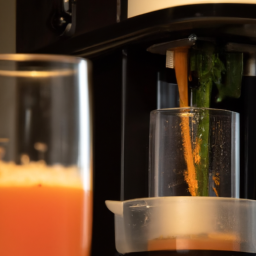
 Juice Tips and Tricks1 week ago
Juice Tips and Tricks1 week agoHow Long Does Juice Last After Juicing
-

 Juice Tips and Tricks1 week ago
Juice Tips and Tricks1 week ago2 Lemons Equal How Much Juice
-

 Vetted3 months ago
Vetted3 months ago15 Best Juices for Diabetics: Refreshing Options That Won’t Spike Your Blood Sugar



